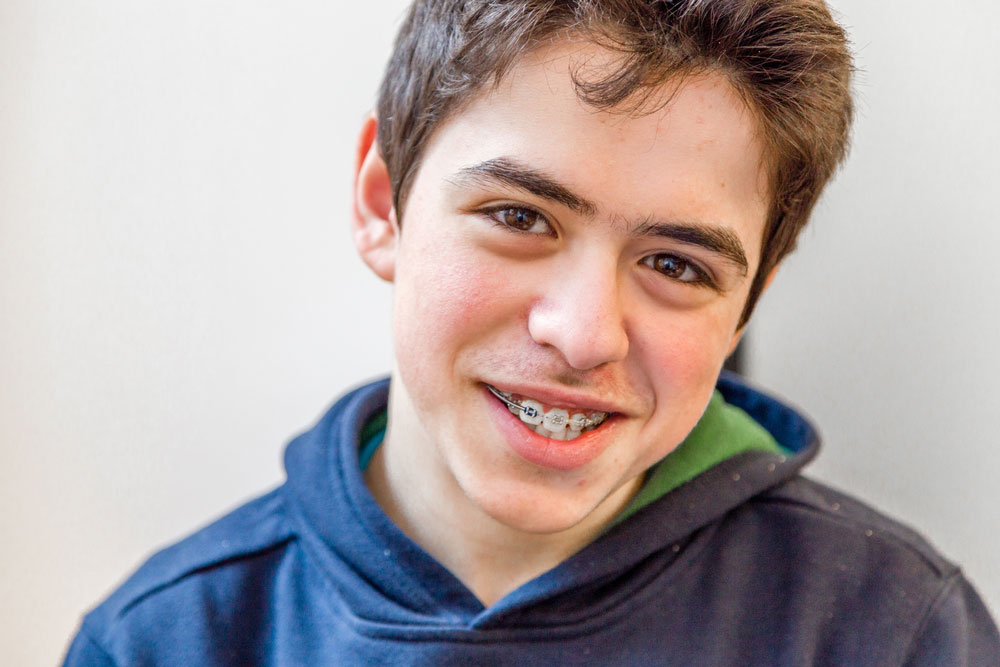
You’ve gotten wired up at the orthodontist’s office as a commitment to your oral health and in pursuit of a beautiful smile. Good for you – good things ahead. To really nail that Hollywood smile, you’ll have to keep up on caring for your braces and teeth, which does add a little bit of extra effort in your oral care routine. Whether it be flossing your teeth with a water flosser or avoiding sticky or crunchy foods, the extra effort will pay off in your overall dental hygiene. Lucky for you, we’ve consolidated all the information you’ll need to ace the brace. Get ready for a class of Braces Care 101, because below are our best tips for ensuring good oral hygiene with braces.
ToothShower Oral Care Suite on Amazon
Brushing Teeth with Braces
Just like your life before braces, you should continue to brush your teeth twice a day. But you’ll have to add another layer to the brushing process to accommodate your braces.
- Brush as you normally do. Be sure to get the front surface areas of your teeth, the crowns of your molars, and the backsides as you usually do.
Consider that the hardware of your braces creates extra nooks and crannies for bacteria and plaque to settle into. To avoid the unpleasant sequence of events that can stem from that, you’ll have to ensure that the hardware of the braces themselves are also thoroughly cleaned. To do that:
- Position your brush at a 45-degree angle relative to the top line of your braces. Gently brush the topsides of the brackets and connective wires of your braces. (Gentle being the keyword here: Brackets can — and do — break with too much pressure, so go easy.)
- You’ll have to get the underside of those brackets too. Employ the same strategy (a 45-degree angle that follows the underside of the brackets) for both the top and bottom rows to ensure you clean not just the surfaces of your teeth, but the extra surfaces created by the protruding bracket on your teeth.
- If you do accidentally break or loosen a bracket or the wiring of your braces, let your orthodontist know right away and schedule an appointment with them. Delays in repairing your braces can add extra time to your treatment schedule.
Flossing with Braces
Surely, you’ve heard your dentist stress the importance of flossing and how often you should floss. The American Dental Association recommends you floss once per day, and that holds steadfast for those with braces. Braces do add some challenges to flossing your teeth and regular ol’ dental floss doesn’t quite cut it. In some cases, it can even be doing more harm like triggering bleeding gums from braces. Therefore, talking to your dentist or orthodontist about a proper technique can be helpful, especially if you have specific issues such as crowding. There are several products on the market, available at many grocery stores and retailers, that can help ensure you are properly accessing the areas that flossing aims to clean and protect. Here are the best ways to floss with braces:
- A dental threader. This tool makes threading the floss through the space between the front surfaces of your teeth and the mainline wire from your braces easier.
- An interproximal brush. These small, rubbery-bristled brushes are designed to be shimmied into the spaces between the teeth and gums.
- A water flosser. Water flossers use the pressure created by a small, focused water stream to dislodge plaque and food particles from the areas between teeth, including their underside surfaces as well as the gumline between them. Water flossers are especially adept at helping those with braces floss because they don’t need to be threaded around the wire of your braces, lowering the risk of causing damage to the braces. They are generally easy to use and are gentle on the gums. Many water flossers come with add-on replaceable heads specifically designed for cleaning the brackets and wiring of braces.
Avoid Foods that Can Damage Braces
There are several types of food that should be avoided when you have braces as their textures can damage or loosen pieces of your braces. They include:
- Very sticky foods, like caramel, toffee, or taffy. Gum should also be avoided.
- Foods with small particles that can get suck in teeth, such as popcorn, very crunchy foods, and certain types of nuts.
- Food that relies heavily on your teeth for tearing from a larger portion, such as ribs, apples, or corn on the cob. However, you can continue to eat these foods — just cut them up into bite-sized pieces first.
Regularly Scheduled Visits and Check-ups
Be sure to stay on track with your braces’ upkeep appointments. You shouldn’t fall out of routine with visiting your dentist and orthodontist. For most braces regimens, these appointments are not only checkups – they are integral parts of the plan where braces are adjusted as teeth move into position. If you miss these appointments, you could fall off schedule and cause extensions to your braces treatment course. For the same reason, it is also critical that if a piece of your braces breaks or loosens, you schedule an appointment immediately to have it repaired.
If you take proper care of your braces with a good oral hygiene regimen, you’ll be able to get them off on schedule with little to no follow-up work required. Braces can and will make a huge difference not only the cosmetic look of your smile but for your overall oral health.
Sources
- Oral-B: Taking care of your braces. Oral-B, 2015.
https://oralb.com/en-us/oral-health/life-stages/braces/how-to-take-care-of-braces - Reviewed by Michael Friendman, DDS: Caring for teeth and braces and retainers. WebMD Medical Reference, 2019.
https://www.webmd.com/oral-health/guide/care-of-braces-retainers#1 - Georgia School of Orthodontics: Caring for braces. https://www.bracestoday.com/patient-information/caring-for-braces/
- Bryana: 6 Braces care tips. Delta Dental of Washington, 2018
https://www.deltadentalwa.com/blog/entry/2018/06/braces-care-tips
The post Braces Care 101: A Guide appeared first on ToothShower.


Leave a comment (all fields required)